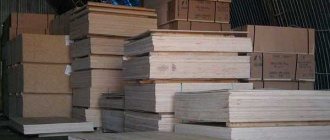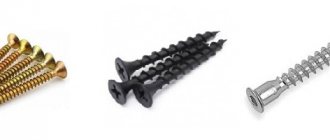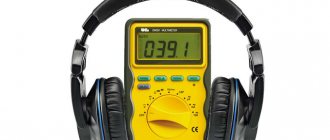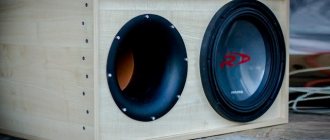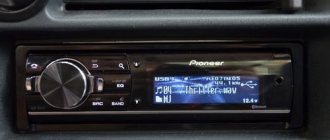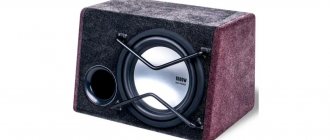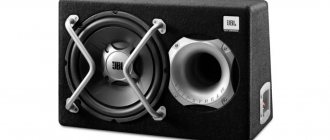Once upon a time I was faced with the task of making good and high-quality sound in my car, in addition to speakers, I decided that for low-frequency sound I needed a subwoofer. But the price and materials of the box forced me to abandon the ready-made decision to buy a ready-made subwoofer. Making a subwoofer with your own hands would be of high quality. And I started by calculating the box for the woofer.
So, I present to your attention the HERTZ ES 300 Speaker.
General characteristics: Type subwoofer Size 30 cm (12 inches) Number of bands 1 Power 350 W (nominal), 700 W (maximum) Sensitivity 92 dB Frequency range 25 - 250 Hz Impedance 4 Ohms
Subwoofer: No enclosure Recommended enclosure: closed box, bass reflex
Woofer: Dimensions 300 mm Diffuser material pressed cellulose Suspension material foam rubber Installation depth 141 mm Installation hole 276 mm
Now you need to know what type of subwoofer boxes there are.
There is a VY (the simplest design, everything is clear from the name), there is a FI (Bass Reflex) VY but with a port (the port can be round (a piece of plastic pipe) or slotted (inside the box they make additional walls of a certain length and volume, there is also a horn, there is CV (as I call the trunk, goodbye) and much more. For myself, I chose the FI that is the most acceptable for me. Later, in a year, I will do a FI with two speakers. But that’s not about that now. The type of body has been selected. Now you need to estimate the net volume ( for me it is 50 liters) and depending on the music you listen to, select the port frequency (I have 35 Hz, which is average or more for all music formats). Next, I downloaded the JBL SpeakerShop program, absolutely free. Using the manual, namely
I entered my speaker data, desired net volume and port setting. To summarize: Net volume - 50 liters Setting 35 Hz Port - 5x32 cm Port length - 70 cm Knowing this, open the following video and calculate the box
Here's what I got
Calculation Complete. Plywood has been purchased. Let's move on to the next stage.
The plywood was sawn into the following pieces:
A - 69.6x35.6 cm - 2 pieces B - 32x32 cm C - 69.6x32 cm D - 33.8x32 cm E - 62.8x32 cm F - 36.2x32 cm G - 25.2x32 cm
I sawed everything off in about 15 minutes with an electric jigsaw. In some places the cuts turned out not to be perfectly even; they had to be sanded a little with very coarse sandpaper (80) nailed to a block to make it flat. First, we screw board B to board A,
Before screwing the wall to the wall, I applied sealant to all joints. then I tightened it around the edges with 2 self-tapping screws (1 on each edge) temporarily, the excess silicone was squeezed out, we removed it with toilet paper or a napkin. Then we take 2 drills. Use a 2.5 mm drill to drill approximately a 5 cm hole, then use a 9 mm drill to drill a recess for the cap. Personally, I made 3 cm gaps between the screws. screwed it on. We wait about 40 minutes and then fasten board by board in order. After we have screwed the ABCD walls on, we apply silicone to all internal joints and cut them with a finger wrapped in a napkin (I cut them with a construction eraser for silicone; there are different cuts in mm at the corners of this eraser). The point is that all internal joints should be generously coated with silicone so that the air displaced by the sub does not escape through the crack and it does not whistle. Once I assembled everything, I coated the holes from the screws with silicone and cut them flat.
We use 88 glue to glue the carpet... I’ll post a video of how I glued it.
An HF box or quarter-wave resonator is a hollow box made of any furniture material. The design is used for a subwoofer and allows for deeper sound with a harmonious spectrum. Such branded devices are quite expensive, but the box can be assembled independently from scrap materials. This is exactly what we will discuss in our review.
Purpose, design and principle of operation of the CV box
The design of the HF box is aimed at modulating the sound flow. The effect of sound transmission and reflection is used. Thanks to the special housing design, sound harmonization is achieved. This is especially noticeable at low frequencies and when installing a subwoofer. With the appropriate dimensions, the HF box will make the bass sound quite loud, bright, but unusually deep.
Subwoofer box
Purpose and use
In a certain context, this device can be compared to an analog-type sound processor. Now that the purpose is clear, let’s now look at the design, operating principle and calculations. The proposed solution is especially in demand among motorists who want to install high-quality sound on used cars; with some effort, it will not be inferior to expensive audio systems.
So, in the technical understanding, the FM box, as implied by the name, is a resonator. We are talking about a hollow structure with the help of which sounds of a given frequency are reproduced. One of the functions of the resonator is to enhance audio sound. Such a device in the car will allow you to listen to loud music, provide musical accompaniment in nature, or use it for commercial purposes, for example, for scoring weddings and celebrations. The most popular solution is a box for a 12-inch speaker.
Making a stealth subwoofer with your own hands
DIY stealth subwoofer Tired of carrying a huge box in the trunk? Then the stealth subwoofer is just made for you. This unique type of case is more practical than the classic box. It doesn't sit in a square box in the middle of the trunk and takes up less space. Often, stealth is installed in the inner part of the wing, sometimes in a niche instead of a spare wheel. The minimum volume of the box that requires a 10-12 inch speaker for normal operation is 18 liters.
To make a passive stealth subwoofer we will need:
subwoofer; protective grille and socket for connection to the amplifier; wire for connecting the speaker to the outlet; multilayer plywood or chipboard (thickness 20 mm); a small piece of fiberboard; epoxy adhesive; brush; fiberglass; mounting tape; polyethylene film; wood screws; drill, jigsaw.
Choosing a location to install the housing
After choosing the place where the stealth will be installed, we empty the trunk and begin manufacturing the body. You can remove the trunk trim where the subwoofer will be installed to place it even closer to the fender. First of all, lay a plastic film on the floor of the trunk. It performs two functions at once: it protects the trunk lining from epoxy glue and allows us to make a mount to which we will screw the bottom of the subwoofer. Next, we cover the inside of the wing with mounting tape in two layers. We cover the trunk with masking tape. We cut the fiberglass into small pieces, approximately 20x20 cm. We put pieces of fiberglass onto the masking tape and glue them with epoxy glue. It is better to overlap the fiberglass fabric so that there are no obvious joints and seams. Epoxy glue + fiberglass mat We sculpt layers of fiberglass on top of each other, simultaneously lubricating them with epoxy glue until the thickness of the sheet reaches 10 mm (about 4-5 layers). The thickness of the panel is approximately 1 cm. The material will harden in approximately 12 hours. To speed up the process, you can use a lamp. Now we cut out the bottom of the subwoofer and glue it to our body. The joint is treated with sealant or glued with epoxy resin. Gluing the bottom In this particular case, the shape needs to be adjusted to the trunk hinges so that our homemade subwoofer does not interfere with its closing. After we cut off all the excess, we cut out the side walls and the top cover from chipboard. We make the rounded part from plywood, we did it “by eye”.
Making the side, top and bottom walls of the box
To make it easier to give the plywood a rounded shape, you must first wet it, give it the desired shape, secure it and let it dry.
Chipboard sheets must be glued with epoxy glue or sealant, and then fastened with self-tapping screws. We also glue the fiberglass box using epoxy resin, and when it dries, we fasten it with self-tapping screws. Gluing and fastening the parts For better sealing, you can glue the seams again. We applied another layer of epoxy glue and pressed the structure with sand to help the glue adhere better. Sandbags for better grip Next we can measure the front panel and cut it out. Using a jigsaw, cut out a circle for the speaker. In order to securely attach the front panel to the body, you need to tighten it with self-tapping screws on all sides. That is, you need to install bars on the entire inside of the panel, at a distance slightly greater than the thickness of the plywood (in our case, we attached the bars at a distance of approximately 25 mm from the edge of the panel). Thanks to this, we will be able to secure the front part at the top, bottom, sides, and most importantly, securely attach it to the rounded element. Preparing the front panel Cut a hole in the end for the socket. Cutting a hole for the terminal block At the end, it was decided to add two more layers of fiberglass and epoxy glue to the curved part of the body for the stealth subwoofer.
We carry out the final assembly: install the socket and connect the speaker to it, but do not screw it yet. Then there are two options - paint the subwoofer, or cover it with carpet. Painting is a little more difficult, since you must first level the surface. For this we used universal putty.
Operating principle
Motorists may be familiar with a resonator, another example of which is the CV box For example, it is used as a functional element of a muffler. In this case, the hollow structure has its own characteristics and another purpose.
From a technical point of view, a resonator is an oscillatory system that accumulates vibrations due to frequency resonance. Typically, the design involves “working” with a limited set of frequency characteristics. Depending on the design, resonators of cumulative and instantaneous action differ.
Homemade wooden box
The storage resonator accumulates external energy by reducing the frequency of internal oscillations. In a mathematical context, any resonator design whose oscillation frequency is greater than the oscillation frequency of the external influence is cumulative. This happens whether the diameter is 10 or 12 inches, but you need to choose a different volume.
Instantaneous action implies the correspondence of the internal oscillatory force in period to external oscillations. Such resonators increase the sound power due to thermal absorption of the surrounding space, shifting the frequency at the input power - changes due to an increase in the playback interval.
The common CV box has a rectangular shape with partitions resembling a caterpillar in arrangement. The appearance will depend on the speaker and its features, size – 10″ or 12 inches. At the moment, you can find drawing diagrams for any frequency device and make a resonator at no extra cost. It will differ slightly from the brand name.
You can make a resonator in a mini version. This solution is shown in the figure.
Drawing of a CV box for 12″
To obtain drawings of 10, 12 and 15″ HF boxes, you can use a search engine or our resonator database or calculation program. The easiest way is to search by type of speaker and required volume. For example, a 12″ CV box can be implemented in several versions, depending on the technical features described and demonstrated below.
How to calculate a resonator for the Urals yourself?
First of all, we note that the main material for making this audio device is multi-layer moisture-resistant plywood. The speaker input is sized according to the selected model. The volume and design will depend on the technical tasks: interior features, required power and other features.
Designs depending on the direction of the port
The figure shows that the direction of the port and other parameters also influence the design. Sometimes drivers, after making calculations, are concerned that the dimensions are very large compared to the available space in the cabin, so they recommend a design that is suitable for this task.
Other housing options
The photo shows an example of the calculation of the HF box, but in total the cross-sectional area of the tunnel is taken into account (for example, 10″ or 12″), depending on the caliber of the subwoofer, for example, Machete m10d2.
Box for URAL (Ural) AK-10
Subwoofer URAL (Ural) AK-10 is quite good in its characteristics and parameters. The boxes for it are very simple and not complicated.
A “closed box” for the URAL (Ural) AK-10 requires 25-30 liters, which is a rather modest figure.
Drawing of the ZYa box for URAL (Ural) AK-10.
A “closed box” for two URAL (Ural) AK-10 will require a volume of 50 liters. For two URAL (Ural) AK-10 this is the optimal volume
Drawing of the ZYa box for two URAL (Ural) AK-10
The bass reflex requires a little more, only 35 liters. The frequency response is quite smooth, the efficiency is 2-3 times greater than the “Closed Box”, very good!
As the volume of the FI box increases, the efficiency also increases, but the frequency response is very distorted, which has a very negative effect on the sound quality. Therefore, I think that the volume of 35 liters is the most suitable for this subwoofer speaker.
Frequency response FI box 35L 38Hz for URAL (Ural) AK-10
Drawing of FI box 35L 38Hz for URAL (Ural) AK-10
Drawing of a FI box 35L 38Hz with a port on the side (with a port on the wing) for URAL (Ural) AK-10
Drawing of FI box 35L 38Hz on 110 pipe for URAL (Ural) AK-10
Fi box for two URAL (Ural) AK-10 should have a volume of 70 liters and a port setting of 38 Hz.
Drawing of a FI box 70L 38Hz for two URAL (Ural) AK-10.
Drawing of a FI box 70L 38Hz with a port on the side (with a port on the wing) for two URAL (Ural) AK-10.
Drawing of a FI box 70L 38Hz on a 160 pipe for two URAL (Ural) AK-10.
Closed box
This type of design is the simplest. A closed box for a subwoofer is easy to calculate and assemble. Its design is a box of several walls, most often 6.
Advantages of ZY:
- Simple calculation;
- Easy assembly;
- Small displacement of the finished box, and therefore compact;
- Good impulsive characteristics;
- Fast and clear bass. Plays club tracks well.
A closed box has only one drawback, but sometimes it is decisive. This type of design has a very low level of efficiency compared to other boxes. A closed box is not suitable for those who want high sound pressure.
However, it is suitable for fans of rock, club music, jazz and the like. If a person wants bass, but needs space in the trunk, then a closed box is an ideal option. A closed box will not play well if the wrong volume is selected. What volume of box is needed for this type of design was long ago decided by experienced people in car audio through calculations and experiments. The choice of volume will depend on the size of the subwoofer speaker.
The most common speaker sizes are: 6, 8, 10, 12, 15, 18 inches. But you can also find speakers of other sizes; as a rule, they are used very rarely in installations. Subwoofers with a diameter of 6 inches are produced by several companies and are also rarely found in installations. Mostly people choose speakers with a diameter of 8-18 inches. Some people indicate the diameter of the subwoofer speaker in centimeters, which is not entirely correct. In professional car audio, it is customary to express dimensions in inches.
Recommended volume for a closed box subwoofer:
- an 8-inch subwoofer (20 cm) requires 8-12 liters of net volume,
- for 10-inch (25 cm) 13-23 liters of net volume,
- for 12-inch (30 cm) 24-37 liters of net volume,
- for 15-inch (38 cm) 38-57 liters net volume
- and for 18 inches (46 cm) you will need 58-80 liters.
The volume is given approximately, since for each speaker you need to select a certain volume based on its characteristics. The setting of a closed box will depend on its volume. The larger the volume of the box, the lower the tuning frequency of the box will be, the bass will be softer. The smaller the volume of the box, the higher the frequency of the box, and the bass will be clearer and faster. You should not increase or decrease the volume too much, as this is fraught with consequences. When calculating the box, adhere to the volume that was indicated above. If there is too much volume, the bass will turn out vague and indistinct. If the volume is not enough, then the bass will be very fast and “pound” the ears in the worst sense of the word.
A lot depends on how the box is configured, but an equally important point is “Setting up the radio.”
Bass reflex
This type of design is quite more difficult to calculate and build. Its design is significantly different from a closed box. However, it has advantages, namely:
- High level of efficiency. A bass reflex will produce low frequencies much louder than a closed box;
- Simple calculation of the body;
- Reconfiguration if necessary. This is especially important for beginners;
- Good speaker cooling.
The bass reflex also has disadvantages, the number of which is greater than that of the ZYa. So, the cons:
- FI is louder than ZY, but the bass here is not so clear and fast;
- The dimensions of the FI box are much larger compared to the ZY;
- Large displacement. Because of this, the finished box will take up more space in the trunk.
Based on the advantages and disadvantages, you can understand where FI boxes are used. Most often they are used in installations where loud and pronounced bass is needed. The bass reflex is suitable for listeners of any rap, electronic and club music. It is also suitable for those who do not need free space in the trunk, since the box will occupy almost all the space.
The FI box will help you get more bass than from a small-diameter speaker. However, this will require much more space.
What volume of box is required for a bass reflex?
- for a subwoofer with a diameter of 8 inches (20 cm) you will need 20-33 liters of net volume;
- for a 10-inch speaker (25 cm) – 34-46 liters,
- for 12-inch (30 cm) – 47-78 liters,
- for 15-inch (38 cm) – 79-120 liters
- and for an 18-inch subwoofer (46 cm) you need 120-170 liters.
As with ZY, the numbers given here are imprecise. However, in a FI case you can “play” with the volume and take a value less than recommended, finding out at what volume the subwoofer plays better. But do not increase or decrease the volume too much, this can lead to loss of power and failure of the speaker. It is best to rely on the recommendations of the subwoofer manufacturer.
What does the FI box setting depend on?
The larger the volume of the box, the lower the tuning frequency, the bass speed decreases. If a higher frequency is needed, then the volume must be reduced. If your amplifier's rated power exceeds the speaker's rating, then it is recommended to make the volume smaller. This is necessary in order to distribute the load on the speaker and prevent it from exceeding the stroke. If the amplifier is weaker than the speaker, then we recommend making the volume of the box a little larger. This compensates for the volume due to the lack of power.
The port area should also depend on the volume. The average speaker port area values are as follows:
for an 8-inch subwoofer you will need 60-115 sq.cm,
for 10-inch – 100-160 sq.cm,
for 12-inch – 140-270 sq.cm,
for 15-inch – 240-420 sq.cm,
for 18-inch - 360-580 sq.cm.
The length of the port also affects the tuning frequency of the subwoofer box; the longer the port, the lower the box tuning; the shorter the port, the higher the tuning frequency. When calculating a box for a subwoofer, first of all, you need to familiarize yourself with the characteristics of the speaker and the recommended parameters of the housing. In some cases, the manufacturer recommends completely different box parameters than those given in the article. The speaker may have non-standard characteristics, causing it to require a specific box. Such subwoofers are most often found from manufacturing companies Kicker and DD. However, other manufacturers also have such speakers, but in much smaller quantities.
The volumes are approximate, from start to finish. It will differ depending on the speaker, but as a rule they will be in the same plug... For example, for a 12-inch subwoofer it is 47-78 liters and the port will be from 140 to 270 sq. cm, but how to calculate the volume in more detail, we will learn all this in subsequent articles. We hope that this article answered your question, if you have comments or suggestions, you can leave your comment below.
The information you learned is perfect for those who want to learn how to count boxes on their own.

